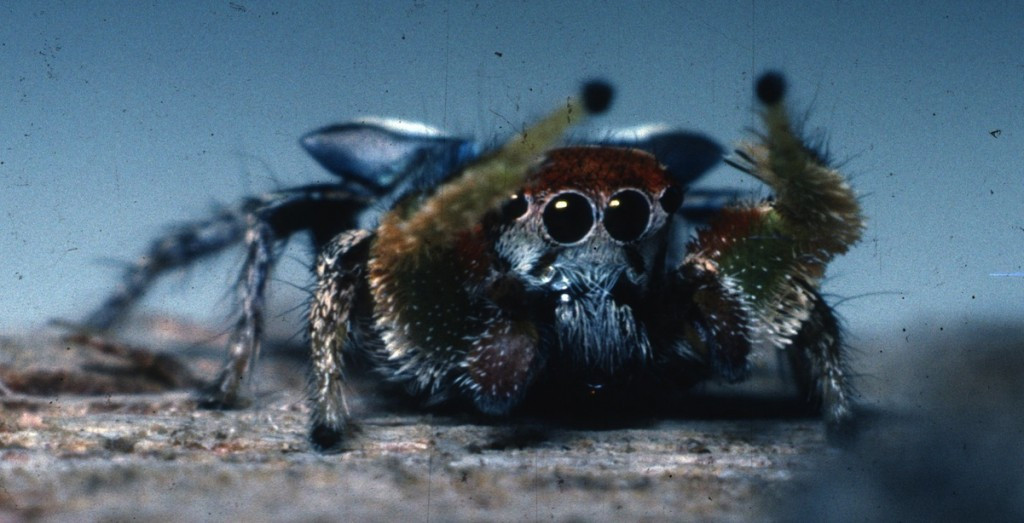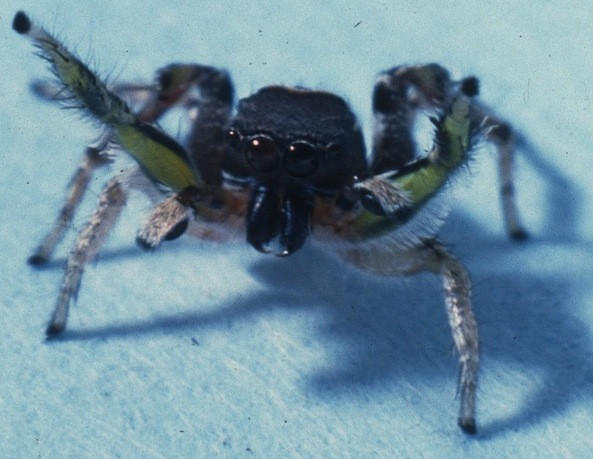When we think of elaborate courtship displays in the animal kingdom, creatures like birds of paradise with their upside-down branch acrobatics or mantis shrimp with their complex signaling might come to mind. However, for sheer complexity relative to size, the Dancing Spider, more accurately known as the jumping spider (family Salticidae), truly steals the show. These tiny arachnids perform courtship rituals that are nothing short of mesmerizing ballets.
 A vibrantly colored male dancing spider (Habronattus species) perched on a leaf, highlighting the intricate beauty involved in jumping spider courtship.
A vibrantly colored male dancing spider (Habronattus species) perched on a leaf, highlighting the intricate beauty involved in jumping spider courtship.
“The first time I would have seen a habernatus dance would have been in 1974,” recalls Wayne Maddison, a distinguished zoologist and Director of the Beaty Biodiversity Museum at the University of British Columbia. His initial encounter with a male dancing spider’s courtship was captivating. As he watched, entranced, the intricate dance unfolded, leaving him pondering, “Oh my god is this complexity ever going to end?” This initial wonder sparked a decades-long fascination with these tiny dancers.
Decoding the Dancing Spider’s Moves
Decades later, Dr. Maddison, along with his colleague Damian Elias at the University of California, Berkeley, continues to delve into the world of dancing spider courtship. Utilizing high-definition video technology, they meticulously analyze these elaborate displays, essentially reverse-engineering the choreography of nature’s smallest performers.
Dr. Maddison shares a video on his computer, and the five-millimeter male dancing spider springs into action. The display is a flurry of precisely coordinated movements: sharp snaps, legs waving in intricate patterns, rhythmic to-and-fro motions, and palpable thrumming vibrations. The spider’s palps, small appendages near its mouth, rotate in rapid circles, while it navigates on just four of its eight legs, the others held aloft in a poised display.
Scientists have broken down these performances into seven distinct stages, each further subdivided into substages, resembling “a medley of seven tunes,” as Maddison describes. These courtship dances can extend up to 20 minutes, a significant portion of a dancing spider’s lifespan, making it a truly dedicated endeavor. Perhaps “jumping spider” is a misnomer; “dancing spider” or “Ziegfield folly spider” might be more fitting names for these tiny choreographers.
 Expert zoologist Wayne Maddison studies high-definition video of dancing spider courtship rituals, revealing the intricate choreography of these tiny performers.
Expert zoologist Wayne Maddison studies high-definition video of dancing spider courtship rituals, revealing the intricate choreography of these tiny performers.
The Evolutionary Rhythm Behind the Dance
But why such elaborate performances? The answer lies in the dynamic of male-female interaction. In the world of dancing spiders, the female is often unimpressed, the discerning critic in this tiny theatre. As Maddison puts it, “So the female wants to say no but he puts it in big bright letters ‘new and improved.'” The male’s complex dance is essentially an attempt to bypass the female’s rejection threshold, an evolutionary arms race played out in miniature.
This process is known as antagonistic co-evolution, a driving force in the evolution of parasite-host relationships. As one partner evolves a defense (the female’s increasing pickiness), the other (the male) evolves a more elaborate strategy to overcome it. The dancing spider’s bells and whistles, therefore, are not merely romantic gestures but evolutionary armament.
Maddison’s initial thought upon witnessing his first dancing spider, “Oh my god is this complexity ever going to end?” inadvertently captured the essence of this ongoing evolutionary dance. The male dancing spider’s courtship is likely to become even more intricate over time, matched only by the female’s ever-increasing selectivity.
For those captivated by these miniature marvels, much like Dr. Maddison, there’s more to discover. Maddison recently identified a new species of dancing spider in Ecuador. While it awaits a formal name, the world of dancing spiders continues to expand, promising even more intricate dances to be unveiled.
